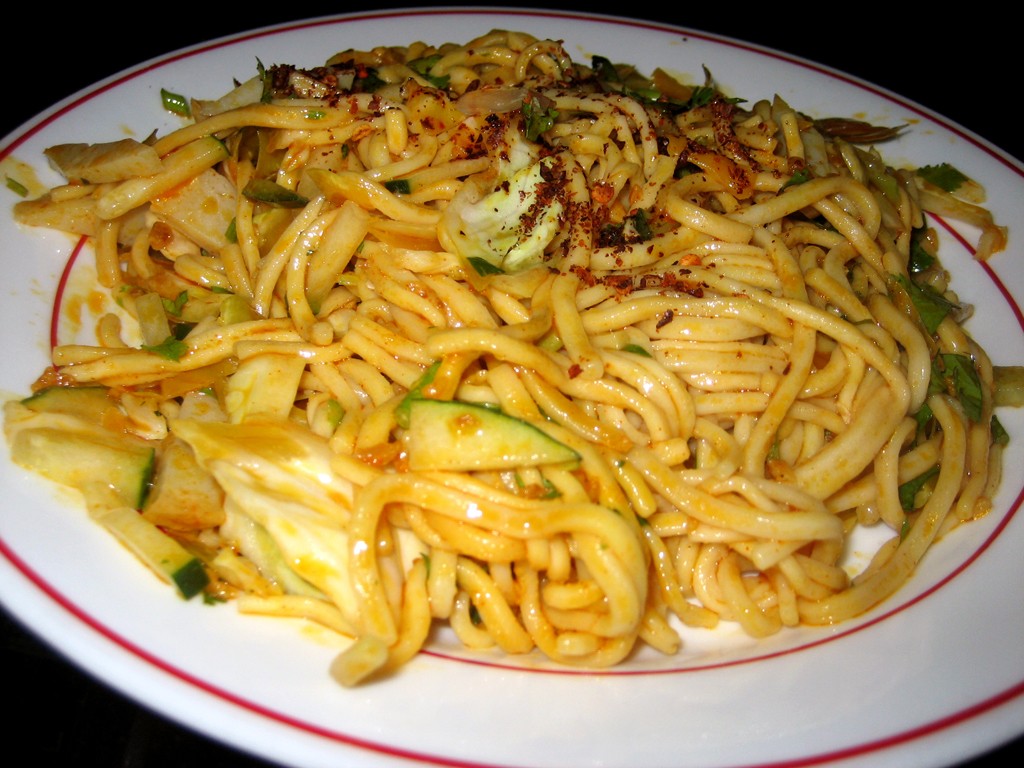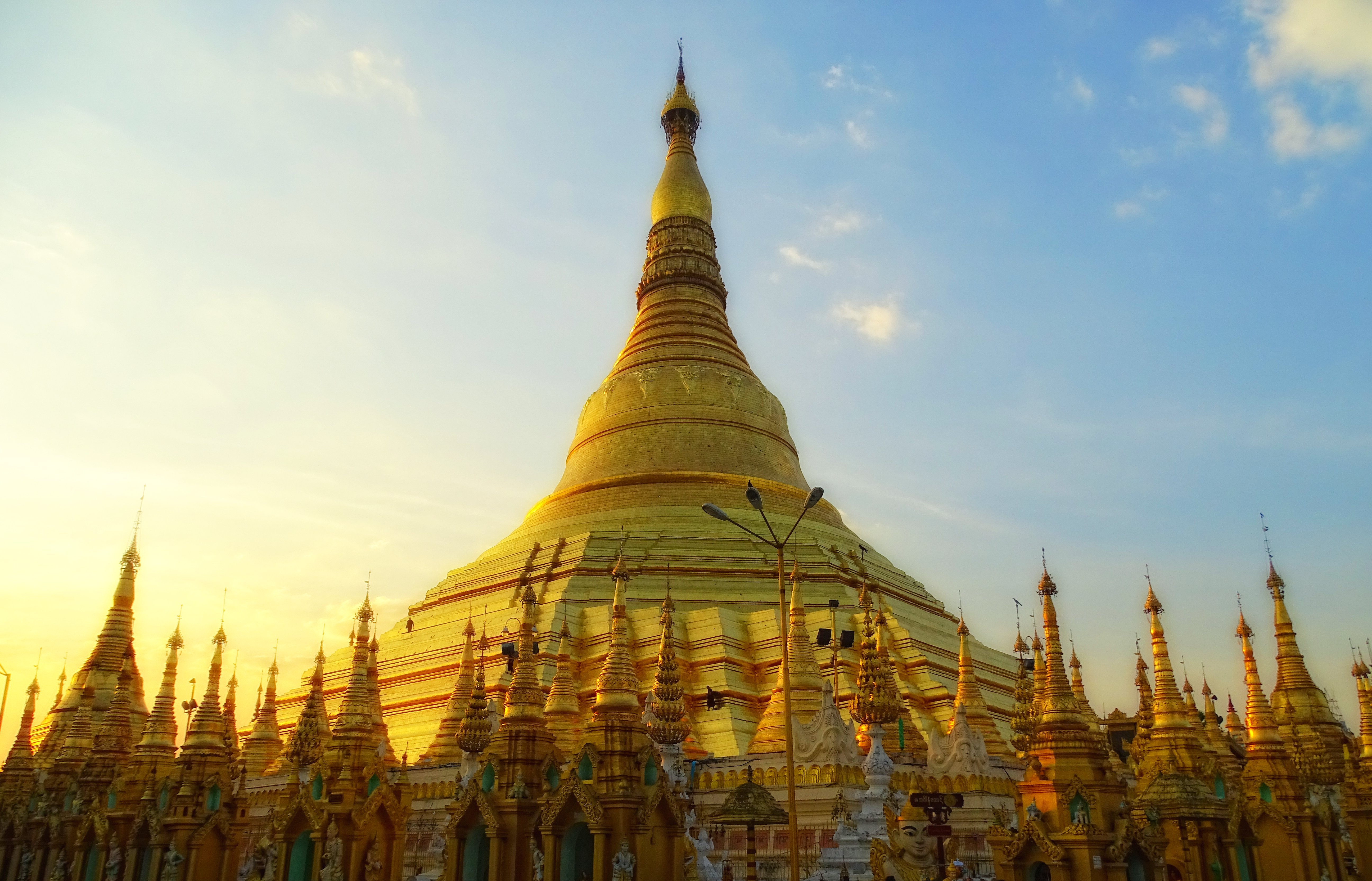|
Htamanè
Htamanè ( my, ထမနဲ, , mnw, ယိုဟ်သ္ၚု,also spelt htamane) is a glutinous rice-based savory snack, and a seasonal festive delicacy in Myanmar. The traditional delicacy is ceremonially prepared around and on the full moon day of Tabodwe (), the 11th lunar month on the traditional Burmese calendar (roughly in February), just as the cool season ends. Some pagodas and monasteries, including the Shwedagon Pagoda, hold htamane-making competitions (). Preparation The preparation begins with washing and soaking white and purple (nga cheik) glutinous rice. In a giant wide wok on a low stove, the glutinous rice is kneaded, crushed and boiled with water and ground nut oil until it becomes a thick blackish grey paste. The wok is lowered from the stove on to a small wooden block to hold it. Once there, the mixing process which is the main feature of making Htamanè begins. Typically, three people (almost always stout men) are involved in the mixing process. Two men ea ... [...More Info...] [...Related Items...] OR: [Wikipedia] [Google] [Baidu] |
Mon People
The Mon ( mnw, ဂကူမည်; my, မွန်လူမျိုး, ; th, มอญ, ) are an ethnic group who inhabit Lower Myanmar's Mon State, Kayin State, Kayah State, Tanintharyi Region, Bago Region, the Irrawaddy Delta, and several areas in Thailand (mostly in Pathum Thani province, Phra Pradaeng district, Phra Pradaeng and Nong Ya Plong district, Nong Ya Plong). There are also small numbers of Mon people in West Garo Hills, calling themselves Man or Mann, who also came from Myanmar to Assam, ultimately residing in Garo Hills. The native language is Mon language, Mon, which belongs to the Monic languages, Monic branch of the Austroasiatic languages, Mon-Khmer language family and shares a common origin with the Nyah Kur language, which is spoken by the Nyah Kur people, people of the same name that live in Northeastern Thailand. A number of languages in Mainland Southeast Asia are influenced by the Mon language, which is also in turn influenced by those language ... [...More Info...] [...Related Items...] OR: [Wikipedia] [Google] [Baidu] |
Glutinous Rice
Glutinous rice ('' Oryza sativa var. glutinosa''; also called sticky rice, sweet rice or waxy rice) is a type of rice grown mainly in Southeast and East Asia, and the northeastern regions of South Asia, which has opaque grains, very low amylose content, and is especially sticky when cooked. It is widely consumed across Asia. It is called glutinous ( la, glūtinōsus) in the sense of being glue-like or sticky, and not in the sense of containing gluten (which it does not). While often called ''sticky rice'', it differs from non-glutinous strains of japonica rice which also become sticky to some degree when cooked. There are numerous cultivars of glutinous rice, which include ''japonica'', ''indica'' and ''tropical japonica'' strains. History In China, glutinous rice has been grown for at least 2,000 years. However, researchers believe that glutinous rice distribution appears to have been culturally influenced and closely associated with the early southward migration and ... [...More Info...] [...Related Items...] OR: [Wikipedia] [Google] [Baidu] |
List Of Burmese Dishes
The following is a list of dishes found in Burmese cuisine. Burmese cuisine includes dishes from various regions of Burma (now officially known as Myanmar). The diversity of Myanmar's cuisine has also been contributed to by the myriad of local ethnic minorities. The Bamars are the most dominant group, but other groups including the Chin people also have distinct cuisines. Burmese cuisine is characterized by extensive use of fish products like fish sauce and ngapi (fermented seafood). Owing to the geographic location of Myanmar, Burmese cuisine has been influenced by Chinese cuisine, Indian cuisine and Thai cuisine. Burmese salads Bamar influenced Chinese inspired Indian inspired Kachin inspired Rakhine inspired Shan inspired Mon inspired Hin Desserts See also * Burmese cuisine Burmese cuisine () encompasses the diverse regional culinary traditions of Myanmar, which have developed through longstanding agricultural practices, centuries of s ... [...More Info...] [...Related Items...] OR: [Wikipedia] [Google] [Baidu] |
Tabodwe
Tabodwe ( my, တပို့တွဲ) is the eleventh month of the traditional Burmese calendar. Festivals and observances *Full moon of Tabodwe **Htamanè, Harvest Festival () **Mon National Day Rakhine people, Rakhine tug of war festival, Yatha Hswe Pwe. *Pagoda festivals **Alaungdaw Kathapa Pagoda Festival (Sagaing Region) **Shwe Settaw Pagoda Festival (Minbu Township, Magwe Region) **Kyaikkhauk Pagoda Festival (Thanlyin Township, Yangon Region) Tabodwe symbols *Flower: ''Butea monosperma'' References See also *Burmese calendar *Festivals of Burma {{Burmese months Months of the Burmese calendar ... [...More Info...] [...Related Items...] OR: [Wikipedia] [Google] [Baidu] |
1977 Burmese Calendar
Events January * January 8 – 1977 Moscow bombings, Three bombs explode in Moscow within 37 minutes, killing seven. The bombings are attributed to an Armenian separatist group. * January 10 – Mount Nyiragongo erupts in eastern Zaire (now the Democratic Republic of the Congo). * January 17 ** 49 marines from the and are killed as a result of a collision in Barcelona harbour, Spain. * January 18 ** Scientists identify a previously unknown Bacteria, bacterium as the cause of the mysterious Legionnaires' disease. ** Australia's worst Granville rail disaster, railway disaster at Granville, a suburb of Sydney, leaves 83 people dead. ** SFR Yugoslavia Prime minister Džemal Bijedić, his wife and 6 others are killed in a plane crash in Bosnia and Herzegovina. * January 19 – An Ejército del Aire CASA C-207 Azor, CASA C-207C Azor (registration T.7-15) plane crashes into the side of a mountain near Chiva, Valencia, Chiva, on approach to Valencia Airport in Spain, killing all ... [...More Info...] [...Related Items...] OR: [Wikipedia] [Google] [Baidu] |
Myanmar
Myanmar, ; UK pronunciations: US pronunciations incl. . Note: Wikipedia's IPA conventions require indicating /r/ even in British English although only some British English speakers pronounce r at the end of syllables. As John Wells explains, the English spellings of both Myanmar and Burma assume a non-rhotic variety of English, in which the letter r before a consonant or finally serves merely to indicate a long vowel: �mjænmɑː, ˈbɜːmə So the pronunciation of the last syllable of Myanmar as ɑːror of Burma as ɜːrməby some speakers in the UK and most speakers in North America is in fact a spelling pronunciation based on a misunderstanding of non-rhotic spelling conventions. The final ''r'' in ''Myanmar'' was not intended for pronunciation and is there to ensure that the final a is pronounced with the broad ''ah'' () in "father". If the Burmese name my, မြန်မာ, label=none were spelled "Myanma" in English, this would be pronounced at the end by al ... [...More Info...] [...Related Items...] OR: [Wikipedia] [Google] [Baidu] |
Traditional Burmese Calendar
A tradition is a belief or behavior (folk custom) passed down within a group or society with symbolic meaning or special significance with origins in the past. A component of cultural expressions and folklore, common examples include holidays or impractical but socially meaningful clothes (like lawyers' wigs or military officers' spurs), but the idea has also been applied to social norms such as greetings. Traditions can persist and evolve for thousands of years—the word ''tradition'' itself derives from the Latin ''tradere'' literally meaning to transmit, to hand over, to give for safekeeping. While it is commonly assumed that traditions have an ancient history, many traditions have been invented on purpose, whether that be political or cultural, over short periods of time. Various academic disciplines also use the word in a variety of ways. The phrase "according to tradition", or "by tradition", usually means that whatever information follows is known only by oral tradition, ... [...More Info...] [...Related Items...] OR: [Wikipedia] [Google] [Baidu] |
Shwedagon Pagoda
The Shwedagon Pagoda (, ); mnw, ကျာ်ဒဂုၚ်; officially named ''Shwedagon Zedi Daw'' ( my, ရွှေတိဂုံစေတီတော်, , ) and also known as the Great Dagon Pagoda and the Golden Pagoda is a gilded stupa located in Yangon, Myanmar. The Shwedagon is the most sacred Buddhist pagoda in Myanmar, as it is believed to contain relics of the four previous Buddhas of the present kalpa. These relics include the staff of Kakusandha, the water filter of Koṇāgamana, a piece of the robe of Kassapa, and eight strands of hair from the head of Gautama. Built on the high Singuttara Hill, the tall pagoda stands above sea level,The pagoda's pinnacle height (to the tip of its ''hti'') is tall per (UNESCO 2018), and is built on the Singuttara Hill, which is tall per , and tall above sea level per and dominates the Yangon skyline. Yangon's zoning regulations, which cap the maximum height of buildings to above sea level (75% of the pagoda's sea l ... [...More Info...] [...Related Items...] OR: [Wikipedia] [Google] [Baidu] |
Making Htamanè
{{Short pages monitor ... [...More Info...] [...Related Items...] OR: [Wikipedia] [Google] [Baidu] |
Burmese Monasteries
A ''kyaung'' (, ) is a monastery ( vihara), comprising the domestic quarters and workplaces of Buddhist monks. Burmese ''kyaungs'' are sometimes also occupied by novice monks (samanera), lay attendants (''kappiya''), nuns (''thilashin''), and young acolytes observing the five precepts ( ''phothudaw''). The ''kyaung'' has traditionally been the center of village life in Burma, serving as both the educational institution for children and a community center, especially for merit-making activities such as construction of buildings, offering of food to monks and celebration of Buddhist festivals, and observance of uposatha. Monasteries are not established by members of the sangha, but by laypersons who donate land or money to support the establishment. ''Kyaungs'' are typically built of wood, meaning that few historical monasteries built before the 1800s are extant. Kyaungs exist in Myanmar (Burma), as well as in neighboring countries with Theravada Buddhist communities, including ne ... [...More Info...] [...Related Items...] OR: [Wikipedia] [Google] [Baidu] |
Buddha
Siddhartha Gautama, most commonly referred to as the Buddha, was a wandering ascetic and religious teacher who lived in South Asia during the 6th or 5th century BCE and founded Buddhism. According to Buddhist tradition, he was born in Lumbini, in what is now Nepal, to royal parents of the Shakya clan, but renounced his home life to live as a wandering ascetic ( sa, śramaṇa). After leading a life of begging, asceticism, and meditation, he attained enlightenment at Bodh Gaya in what is now India. The Buddha thereafter wandered through the lower Indo-Gangetic Plain, teaching and building a monastic order. He taught a Middle Way between sensual indulgence and severe asceticism, leading to Nirvana, that is, freedom from ignorance, craving, rebirth, and suffering. His teachings are summarized in the Noble Eightfold Path, a training of the mind that includes meditation and instruction in Buddhist ethics such as right effort, mindfulness, and '' jhana''. He die ... [...More Info...] [...Related Items...] OR: [Wikipedia] [Google] [Baidu] |

.jpg)




.jpg)